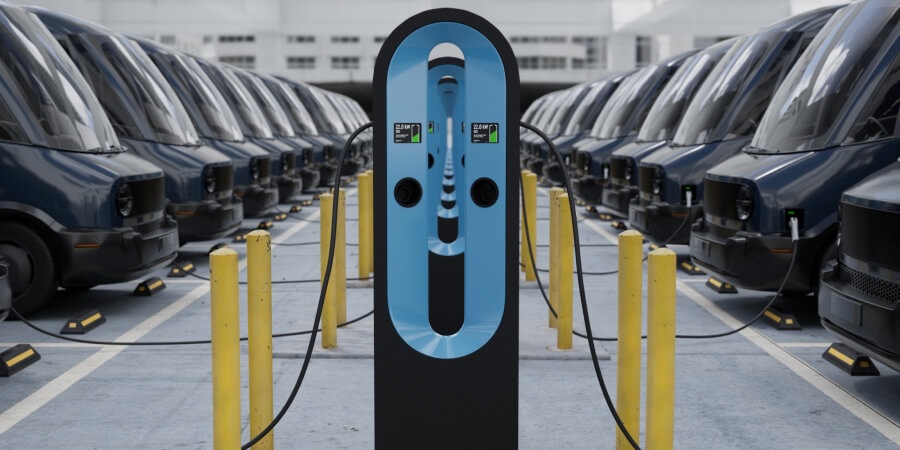Electric vehicle barriers: Overcoming EV barriers in city and state fleets

Dozens of city and state fleets across North America are adopting EVs for a more sustainable future. Canada has set a goal for 100% EV sales by 2035, while U.S. municipalities have taken hundreds of promotional actions for EVs since 2021.
But while EV adoption is always worth the effort, the first step may prove difficult for public organizations. Today, more than half of all surveyed fleet managers say that the cost of infrastructure and EVs is a major barrier to adoption.
If you’re looking to overcome or understand the barriers to EV adoption, you need to survey the existing landscape so you can evaluate solutions. Let’s discuss everything that you should know to make an informed decision.
Understanding common electric vehicle barriers in city and state fleets
Acquiring EVs for your government fleet is a complex project at best. The largest and most formidable obstacles to EV adoption include the following.
Lack of charging infrastructure
The low availability of charging stations can make it difficult to charge your public EV fleet. Recent statistics show that the U.S. needs more than 1 million new vehicle chargers to meet demand by 2030, which means many city and state localities are unable to reliably charge their fleets.
High upfront expenses
EVs may be more expensive than traditional models due to their newer, longer-lasting componentry. In 2023, the average price of an EV reached $52,469, not including the costs of electric charging stations (which are approximately $12,700 per Level 2 charger).
Poor vehicle availability
Even if your organization has the budget to acquire EVs, you may be kept on a waiting list until new models arrive. Approximately two in three nationwide car dealerships don’t have any EVs for sale, which means you may need to wait for long periods of time before your specific models reach your area.
Low availability of telematics
Public organizations have been using telematics for traditional vehicles for years. However, finding similar alternatives for EVs may prove to be a significant challenge. Many telematics providers struggle to develop solutions due to non-standardized data protocols and lagging industry requirements. This means your selection of EV telematics may be somewhat limited at present.
Overcoming city and state EV adoption challenges
Effectively adopting EVs requires a great deal of planning and forethought. Although every city and state agency may have different goals and barriers, the following tips can help when designing sustainability plans.
1. Starting with EV infrastructure
Before acquiring your first EV, you should determine the extent of your charging infrastructure. Parking lots, garages, and other public spaces may need additional installations to make charging more efficient.
Keep in mind that design is everything when it comes to EV charging infrastructure, especially the number and quality of stations that you want in dedicated areas. You may also want to partner with local utility companies to get a better understanding of your electrical bandwidth.
2. Reallocating savings
While EVs may cost more up front, they also provide significant savings over time. Studies show that driving with electricity is cheaper than gas in every U.S. state, with as much as $12,000 in maintenance savings over the course of an operational lifetime.
You can use the savings generated by your EVs to invest in additional solutions. If you want to speed up the timeline for your breakeven point, you can also take advantage of grant funds and rebates. Both the U.S. and Canada offer multiple incentives so state and city governments can purchase EVs.
3. Relying on cooperative contracts
A cooperative contract is a cost-effective method of procuring EV infrastructure for your fleet. Competitively solicited cooperative contracts can help you locate tools, software, and equipment at a faster pace and for a more competitive price.
An effective partnership with the right agency can help you locate:
- Charging stations
- Telematics
- EV models
Remember, organizations like Sourcewell can play a significant role in finding the right cooperative contract(s) for your organization.
Vetting reliable partners for city or state EV adoption
Whether you’re a major metro, a small locality, or a larger state or territory, overcoming the barriers to EV fleet adoption starts with finding the right organizational partners.
You can rely on notable partners like:
- Sourcewell, which can help you explore cooperative contracts at no extra cost
- Electrification Coalition, which can help you identify state and local EV policies
- Climate Mayors, which can help you stay updated on the latest EV news
Partnering with any of these organizations can help you pave the way toward a sustainable future.
See how easy it is to get the EV fleet you need without the hassle, using Sourcewell’s cooperative purchasing program. Streamline the public procurement process by choosing from hundreds of suppliers already on contract. Sourcewell’s procurement experts competitively solicit and award contracts on behalf of 50,000 participating agencies in North America. Check out our EV contracts and more for free here.


